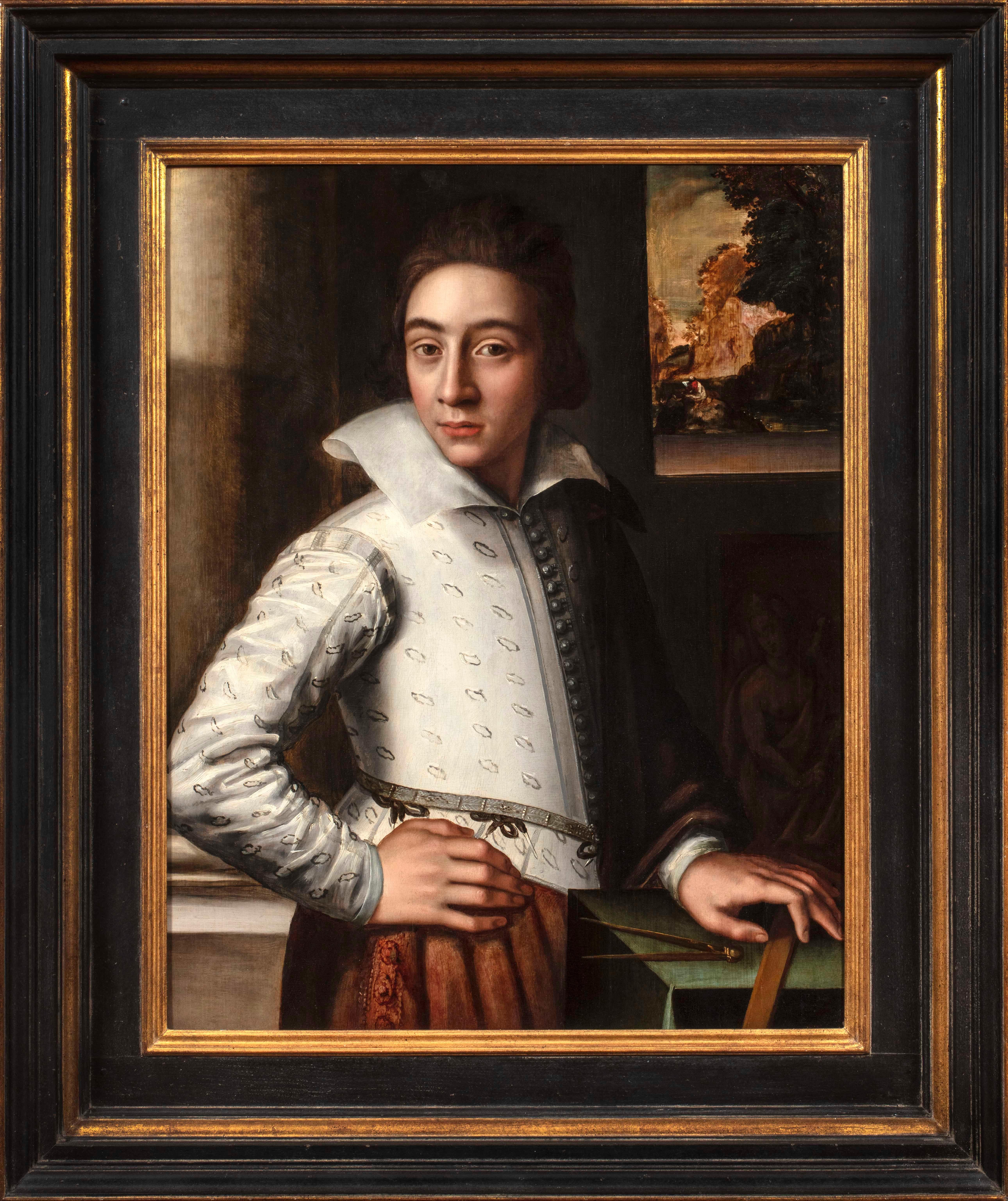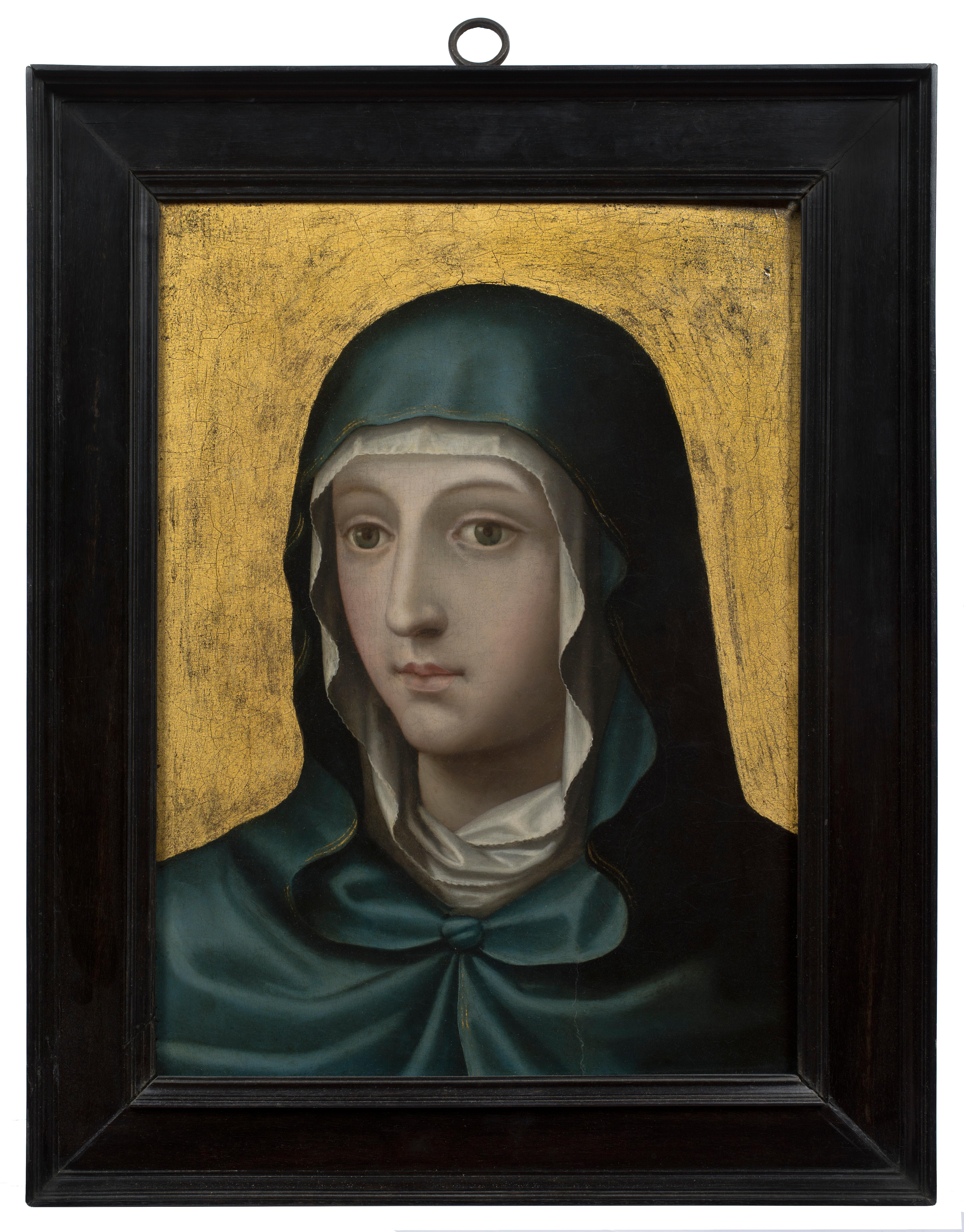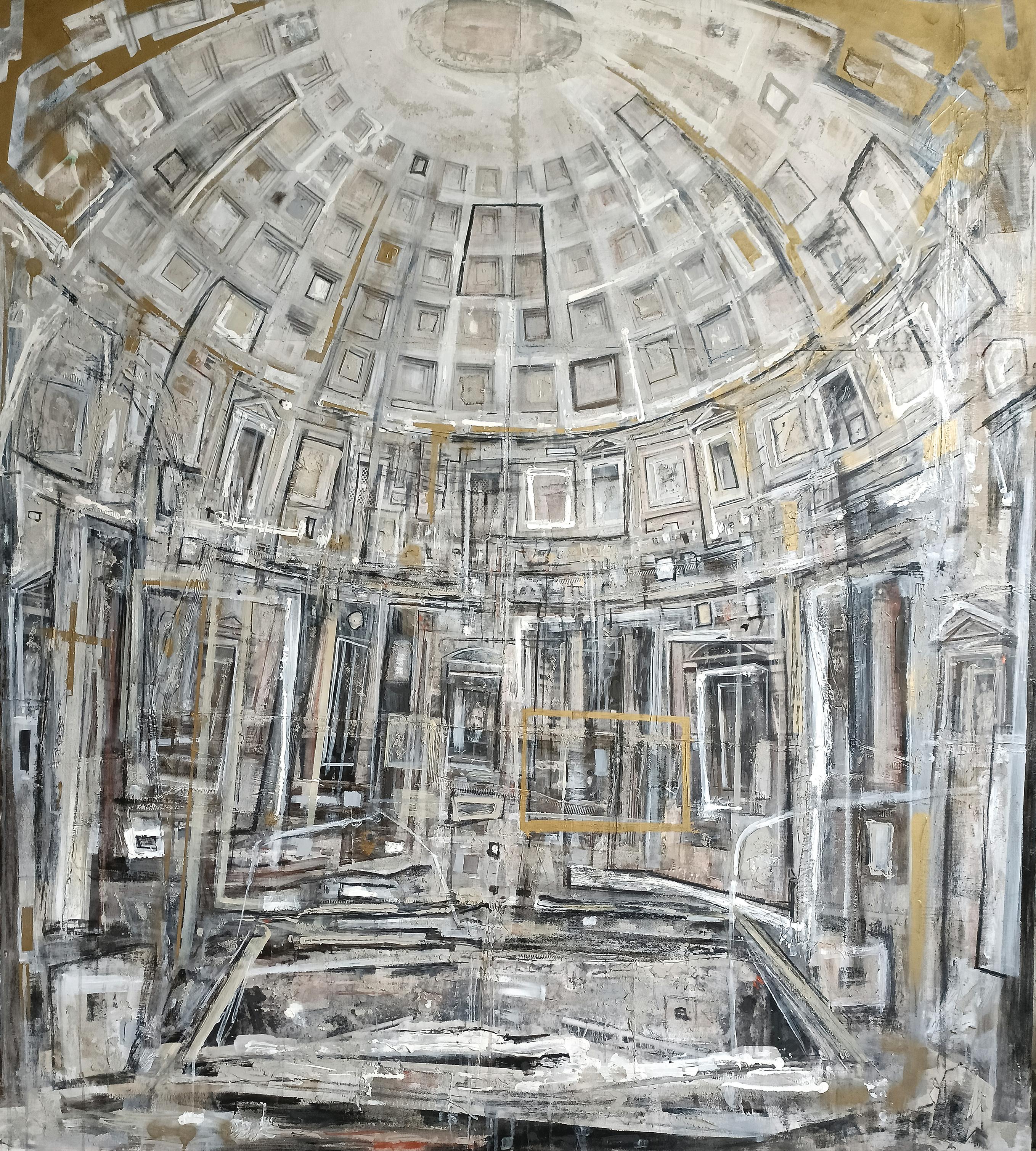Items Similar to Portrait of Thomas Cranmer, Archbishop of Canterbury, Mid 16th Century Oil
Want more images or videos?
Request additional images or videos from the seller
1 of 4
Mid 16th Century English SchoolPortrait of Thomas Cranmer, Archbishop of Canterbury, Mid 16th Century Oil
About the Item
Oil on panel
Image size: 12 1/2 x 8 3/4 inches (31.75 x 22.25 cm)
Period style hand made frame
This is a portrait of Thomas Cranmer (1489 - 1556). Cranmer was the Archbishop of Canterbury in the reign of Henry VIII and launched the English Reformation. Few people have played so important a part in shaping the course of English history or had a more profound influence on England's language and literature than Thomas Cranmer.
At the bottom of the painting Cranmer's name and title is inscribed. At the centre there is also Cranmer's coat of arms, the left half is the arms that all archbishops of Canterbury adopt and it has been enjoin to his own family arms that can be seen on the righthand side. It has been noted that Cramer swapped the original stars in his family crests for these pelicans. There was an old belief that pelicans feed their young with their own blood and Cranmer employed the animals to reflect his protestantism and emphasis on atonement by the blood of christ alone.
It is also likely that the books Cranmer holds in his hands are the 'Book of Common Prayer' which was written largely by Cranmer himself in 1549.
A similar portrait of Cranmer is currently in the art collection at Lambeth Palace, London.
- Creator:Mid 16th Century English School (1501 - 1550, English)
- Dimensions:Height: 12.5 in (31.75 cm)Width: 8 in (20.32 cm)
- More Editions & Sizes:1 of 1Price: $9,991
- Medium:
- Period:
- Condition:
- Gallery Location:London, GB
- Reference Number:1stDibs: LU52412163562
About the Seller
5.0
Vetted Seller
These experienced sellers undergo a comprehensive evaluation by our team of in-house experts.
Established in 2007
1stDibs seller since 2014
63 sales on 1stDibs
Typical response time: 2 hours
- ShippingRetrieving quote...Ships From: London, United Kingdom
- Return PolicyA return for this item may be initiated within 14 days of delivery.
More From This SellerView All
- Portrait of a Boy in a Black Tunic - Early 17th Century OilLocated in London, GBFlemish School, Early 17th Century Portrait of a Boy in a Black Tunic Oil on panel Image size: 15¾ x 13⅛ inches This accomplished portrait of an unknown boy in his early teens was p...Category
17th Century Portrait Paintings
MaterialsPanel, Oil
- Portrait of a ManBy Cornelis DusartLocated in London, GBCircle of Cornelis Dusart Dutch 1660 - 1704 Portrait of a Man Oil on panel Image size: 7¾ x 5¼ inches Giltwood frame Cornelis Dusart Cornelis ...Category
17th Century Old Masters Portrait Paintings
MaterialsPanel, Oil
- Portrait of Geoffrey Chaucer, Oil on Oak Panel Portrait, 16th CenturyLocated in London, GBOil on oak panel Image size: 14 1/4 x 11 3/4 inches (36 x 30 cm) Period style frame This portrait shows Chaucer with a string of beads in one hand and a writing implement in the other. The Arms in the top left of the picture are the Arms of Chaucer, featuring a per pale argent and gules, a bend counterchanged. This painting appears to derive, like all other portraits of Chaucer, from an illustration in an early fifteenth-century manuscript, Hoccleve's De Regimine Principum. Here Hoccleve included one portrait of Chaucer, showing him with an inkhorn around his neck and holding a rosary in one hand. Since it is likely that Hoccleve had met Chaucer, many scholars believe this could be the most genuine representation of the English writer with all other depictions being seemingly based on it. In almost all portraits of Chaucer, including this one, the poet is shown wearing a pendant attached to his vest. This item is often considered to be a penner, included in the artworks as a sign of the general occupation of a writer. Whilst the pendant is generally accepted as a case for a writing instrument, possibly with equal plausibility, it has also been suggested that the item is an ampulla, a small lead vial containing water and the blood of St. Thomas Becket...Category
16th Century Portrait Paintings
MaterialsOil, Panel
- Portrait of a Young Man - 17th Century Portrait in OilBy Pieter Harmensz VerelstLocated in London, GBCircle of Pieter Harmensz Verelst 1618 - 1678 Portrait of a Young Man Oil on oak panel Image size: 7 ½ x 5 ¾ inches Dutch ripple frameCategory
18th Century and Earlier Old Masters Portrait Paintings
MaterialsPanel, Oil
- Portrait of a Mary Hardy (nee Sulman), Late 19th Century Victorian OilLocated in London, GBSlade School Late 19th Century Portrait of a Mary Hardy (nee Sulman) Oil on panel Image size: 8 x 7 inches Contemporary frame Provenance Lady Town (Grandda...Category
Late 19th Century Victorian Portrait Paintings
MaterialsOil, Panel
- The Gold Brooch, Orientalist Oil Painting, Signed and dated 1894By Eugene Alexis GirardetLocated in London, GBOil on panel, signed, dated and inscribed ‘Bou Saada, 1894’ lower right Image size: 13 x 8 3/4 inches (33 x 22.25 cm) Ornate Gilt frame Euguene Alexis Girardet A child prodigy, Gi...Category
1890s Portrait Paintings
MaterialsOil, Panel
You May Also Like
- Portrait of a ManLocated in New York, NYProvenance: with Leo Blumenreich and Julius Böhler, Munich, 1924 Dr. Frederic Goldstein Oppenheimer (1881-1963), San Antonio, Texas; by whom given to: Abraham M. Adler, New York, un...Category
16th Century Old Masters Portrait Paintings
MaterialsOil, Panel
- Portrait of an Artist (possibly a Self-Portrait)Located in New York, NYProvenance: Bradley Collection. Private Collection, Upperville, Virginia. Literature: Katlijne van der Stighelen and Hans Vlieghe, Rubens: Portraits of Unidentified and Newly Identified Sitters painted in Antwerp, Corpus Rubenianum Ludwig Burchard, vol. 19, pt. 3, London and Turnhout, 2021, under cat. no. 189, p. 161, and fig. 75. This painting had previously been considered to be by an anonymous Tuscan painter of the sixteenth century in the orbit of Agnolo Bronzino. While the painting does in fact demonstrate a striking formal and compositional similarity to Bronzino’s portraits—compare the nearly identical pose of Bronzino’s Portrait of a Young Man in the Metropolitan Museum of Art (Fig. 1)—its style is completely foreign to Italian works of the period. That it is painted on an oak panel is further indication of its non-Italian origin. This portrait can in fact be confidently attributed to the Antwerp artist Huybrecht Beuckelaer. Huybrecht, the brother of Joachim Beuckelaer, has only recently been identified as the author of a distinct body of work formerly grouped under the name of the “Monogrammist HB.” In recent studies by Kreidl, Wolters, and Bruyn his remarkable career has been delineated: from its beginnings with Joachim in the workshop of Pieter Aertsen; to his evident travels to Italy where, it has been suggested, he came into contact with Bronzino’s paintings; to his return to Antwerp, where he seems to have assisted Anthonis Mor in painting costume in portraits; to his independent work in Antwerp (where he entered the Guild of Saint Luke in 1579); and, later to his career in England where, known as “Master Hubberd,” he was patronized by the Earl of Leicester. Our painting was recently published by Dr. Katlijne van der Stighelen and Dr. Hans Vlieghe in a volume of the Corpus Rubenianum, in which they write that the painting “has a very Italian air about it and fits convincingly within [Beuckelaer’s] oeuvre.” Stighelen and Vlieghe compare the painting with Peter Paul Ruben’s early Portrait of a Man, Possibly an Architect or Geographer in the Metropolitan Museum of Art, in which the sitter holds a compass and wears a similarly styled doublet (Fig. 2). Huybrecht both outlived and travelled further afield than his brother Joachim, who made his career primarily in Antwerp. Whereas Joachim was the main artistic inheritor of their uncle and teacher, Pieter Aertson, working in similar style and format as a specialist in large-scale genre and still-life paintings, Huybrecht clearly specialized as a painter of portraits and was greatly influenced by the foreign artists and works he encountered on his travels. His peripatetic life and his distinctly individual hand undoubtedly contributed to the fact his career and artistic output have only recently been rediscovered and reconstructed. His periods abroad seem to have overlapped with the mature phase of his brother Joachim’s career, who enrolled in the Antwerp Guild of Saint Luke much earlier than his brother, establishing himself as an independent painter in 1560. Joachim’s activity was confined to the following decade and half, and his latest work dates from the last year of his life, 1574. Our portrait was likely produced in the late 1560s, a dating supported by the dendrochronological investigation performed by Dr. Peter Klein, which established that it is painted on an oak panel with an earliest felling date of 1558 and with a fabrication date of ca. 1566. This painting presents a portrait of an artist, almost certainly Huybrecht’s self-portrait. The young sitter is confidently posed in a striking patterned white doublet with a wide collar and an abundance of buttons. He stands with his right arm akimbo, his exaggerated hands both a trademark of Huybrecht and his brother Joachim’s art, as well as a possible reference to the “hand of the artist.” The figure peers out of the painting, interacting intimately and directly with the viewer, as we witness him posed in an interior, the tools and results of his craft visible nearby. He holds a square or ruler in his left hand, while a drawing compass...Category
16th Century Old Masters Paintings
MaterialsOil, Panel
- The Veronica of the Virgin (Verónica de la Virgen)Located in New York, NYThe panel has been attributed both to Joan de Joanes and his son Vicente Macip Comes (Valencia, ca. 1555 – 1623). Provenance: Private Collection, England, by 1886 (according to stencils on the reverse) Private Collection, New Jersey, until 2010 The Veil of Veronica, often called the Sudarium, is one of the most important and well-known relics of Christ. According to legend, Veronica offered Christ her veil as he carried the cross to his crucifixion. He wiped his face with the veil, which left the cloth miraculously imprinted with his image. Depictions of Christ’s face on a veil, or simply images that focused in on Christ’s face, were treasured objects of religious devotion. The popularity of this format also inspired similar images of the face of the Virgin. The iconographic type of the present painting is known as the Veronica of the Virgin, which was especially favored in late medieval and early Renaissance Spain. Distinct from the images of the suffering Christ, the Veronica of the Virgin is based on the legend that Saint Luke painted a portrait of Mary from life. Although scholars have sometimes mistaken them for portraits of Queen Isabella I of Castile (known as Isabel la Católica) or as a depiction of Saint Maria Toribia (known as María de la Cabeza, or, Mary of the Head), paintings like this one were clearly intended as images of the Virgin in the style of Saint Luke’s lost portrait. The Veronica of the Virgin was especially popular in Valencia, and depictions of this subject produced there all stem back to one visual prototype: a Byzantine image in the city’s cathedral (Fig. 1). This early treatment of the Veronica was given to the cathedral in 1437 by Martin the Humane, King of Aragon and Valencia, who promoted religious veneration of the Veronica of the Virgin as part of the celebration of the Immaculate Conception of Mary. This devotion spread throughout Martin’s kingdom and particularly took hold in Valencia, where the Byzantine image resided. The image, which is displayed in a gold reliquary...Category
16th Century Old Masters Paintings
MaterialsOil, Wood Panel
- 18th Century Venetian School Portrait of a Bishop Oil on Panel Green Brown BlackLocated in Sanremo, ITPainting oil on panel measuring 40 x 30 cm without frame and 48 x 38 with frame representing a great bishop of the Venetian school from the first half of the 18th century. Very curi...Category
Early 18th Century Italian School Portrait Paintings
MaterialsOil, Wood Panel
- Torre VelascaLocated in Milano, MIUrbex is the English acronym for urban exploration and is an activity that consists of searching for and locating abandoned infrastructure with the goal of visiting, photographing and conveying its contents, with particular involvement of methodologies from geography, anthropology, sociology to cultural studies. Her works have been in the past approached to the works of Anselm Kiefer (b. 1945) and Giovanni Battista Piranesi (1720-1770), but in Gullotta's paintings the absence of color makes the spaces particularly ethereal, allowing them to be ideally lifted to new places and to new life. An artist of international caliber who has decided to entrust her return to her homeland to Almach Art Gallery in Milan, while maintaining connections with important galleries, such as Marlborough Fine Art in London and Galerie Koch in Hanover. The artwork represents the famous Velasca Tower in Milan. This artwork was exhibited during the Daniela Gullotta...Category
2010s Contemporary Portrait Paintings
MaterialsSandstone
- PantheonLocated in Milano, MIUrbex is the English acronym for urban exploration and is an activity that consists of searching for and locating abandoned infrastructure with the goal of visiting, photographing and conveying its contents, with particular involvement of methodologies from geography, anthropology, sociology to cultural studies. Her works have been in the past approached to the works of Anselm Kiefer (b. 1945) and Giovanni Battista Piranesi (1720-1770), but in Gullotta's paintings the absence of color makes the spaces particularly ethereal, allowing them to be ideally lifted to new places and to new life. An artist of international caliber who has decided to entrust her return to her homeland to Almach Art Gallery in Milan, while maintaining connections with important galleries, such as Marlborough Fine Art in London and Galerie Koch in Hanover. The artwork represents the famous Velasca Tower in Milan. This artwork was exhibited during the Daniela Gullotta...Category
2010s Contemporary Portrait Paintings
MaterialsSandstone
Recently Viewed
View AllMore Ways To Browse
2 Century
12 Century
All Midcentury
Art By Mid
Mid Century Paint
Mid Century Original Art
Hand Painted Mid Century
Panel Midcentury
English Midcentury
Original Midcentury Paintings
Century 16th
London Mid Century
Original Midcentury Art
Mid Century Book
English Images
Young Mid Century
Antique Literature
Antique Cans Of Oil





